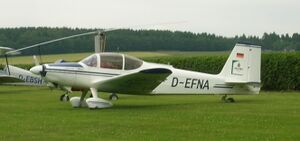Engineering:Oberlerchner JOB 15
| JOB 15 | |
|---|---|

| |
| A JOB 15-180/2 | |
| Role | Two-seat lightplane |
| Manufacturer | Josef Oberlerchner Holzindustrie |
| First flight | 1960 |
| Introduction | 1962 |
| Produced | 1962-1966 |
| Number built | 24 |
| Developed from | Oberlerchner JOB 5 |
The Oberlerchner JOB 15 was an Austrian two-seat light aircraft produced by Josef Oberlerchner Holzindustrie, which had previously designed and built gliders.
Design and development
Using experience as sailplane designers and builders, Josef Oberlerchner Holzindustrie determined to create a powered aircraft. The result was the JOB 5,[1] a two-seat side-by-side light aircraft of wooden construction.[2] It first flew in 1958. The company decided to build a slightly larger three-seat production version, the JOB 15. The JOB 15 was a low-winged monoplane of composite construction with fixed tailwheel undercarriage, with a wooden wing and steel-tube fuselage covered in glass-reinforced plastic and fabric. The prototype first flew in 1960 with a 135 hp (101 kW) Avco Lycoming O-290-D2B engine. Three aircraft were built before the a more powerful version, the JOB 15-150, was built with a 150 hp (112 kW) Avco Lycoming O-320-A2B engine. After 11 15-150s had been built an improved version, the JOB 15-150/2, was introduced and ten were built before production ended in the late 1960s.
Variants
- JOB 5
- Prototype two-seater, 95 hp Continental C90-12F engine, one built
- JOB 15
- Production three-seater with a 135 hp (101 kW) Avco Lycoming O-290 engine, three built.[3]
- JOB 15-150
- Re-engined version with a 150 hp (112 kw) Avco Lycoming O-320-A2B engine, 11 built.
- JOB 15-150/2
- Improved version, ten built.
Specifications (15-150)
Data from Janes's All The World's Aircraft 1969-70[4]
General characteristics
- Crew: 1
- Capacity: 3 passengers
- Length: 7.68 m (25 ft 2 in)
- Wingspan: 10.10 m (33 ft 2 in)
- Height: 1.99 m (6 ft 6 in)
- Wing area: 14.7 m2 (158 sq ft)
- Aspect ratio: 6.94:1
- Airfoil: NACA 643-418 at root, NACA 643-412 at tip
- Empty weight: 601 kg (1,325 lb)
- Max takeoff weight: 965 kg (2,127 lb)
- Fuel capacity: 140 L (37 US gal; 31 imp gal)
- Powerplant: 1 × Avco Lycoming O-320-A2B four-cylinder air-cooled horizontally-opposed engine, 110 kW (150 hp)
Performance
- Maximum speed: 235 km/h (146 mph, 127 kn)
- Cruise speed: 195 km/h (121 mph, 105 kn) (economical cruise)
- Stall speed: 70 km/h (43 mph, 38 kn) (flaps down)
- Never exceed speed: 285 km/h (177 mph, 154 kn)
- Range: 1,000 km (620 mi, 540 nmi) with max payload (65% power)
- Service ceiling: 4,500 m (14,800 ft)
- Rate of climb: 4.40 m/s (866 ft/min)
- Takeoff run to 15 m (50 ft): 306 m (1,000 ft)
- Landing run from 15 m (50 ft): 338 m (1,109 ft)
References
- ↑ The prototype JOB 5 was a side-by-side two-seater powered by Continental C90-12F (95 hp). It was built in 1957 and flew for over 100 hrs during 1958-9. These development flights led the company to incorporate the changes which led to the JOB 15.
- ↑ Walford 1960, p.151.
- ↑ Taylor 1969, p. 7.
- ↑ Taylor 1969, pp. 7–8.
- The Illustrated Encyclopedia of Aircraft (Part Work 1982-1985). Orbis Publishing.
- Mondey, David (1981). Encyclopedia of The World's Commercial and Private Aircraft. New York: Crescent Books.
- Taylor, John W. R., ed (1969). Jane's All The World's Aircraft 1969-70. London: Jane's Yearbooks. ISBN 0-354-00051-9.
- Walford, Edith (18 January 1960). "JOB 5 Sport Plane Enters Final Testing". Aviation Week & Space Technology 72 (3): 131, 135, 137,139. http://archive.aviationweek.com/issue/19600118#!&pid=131.
External links
- Schmidt, Pierre; Alpen-Klassike: Von der JOB 5 zur JOB 15, Modell Aviator, 2009. (German)
 |

